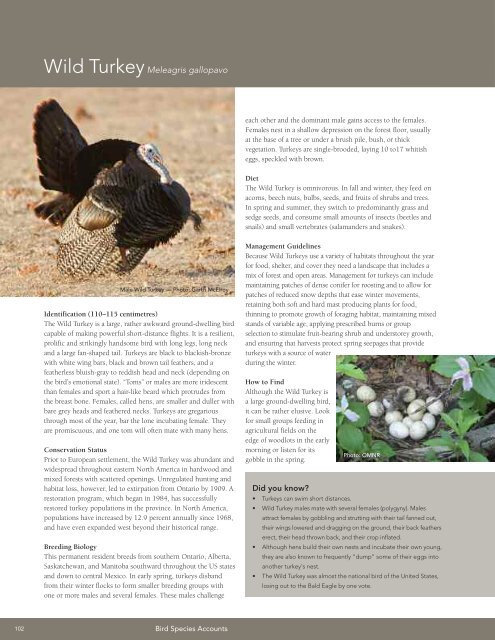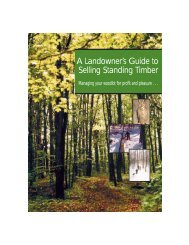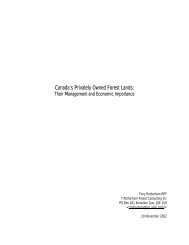A land manager's guide to conserving habitat for forest birds in ...
A land manager's guide to conserving habitat for forest birds in ...
A land manager's guide to conserving habitat for forest birds in ...
Create successful ePaper yourself
Turn your PDF publications into a flip-book with our unique Google optimized e-Paper software.
Wild Turkey Meleagris gallopavo<br />
each other and the dom<strong>in</strong>ant male ga<strong>in</strong>s access <strong>to</strong> the females.<br />
Females nest <strong>in</strong> a shallow depression on the <strong>for</strong>est floor, usually<br />
at the base of a tree or under a brush pile, bush, or thick<br />
vegetation. Turkeys are s<strong>in</strong>gle-brooded, lay<strong>in</strong>g 10 <strong>to</strong>17 whitish<br />
eggs, speckled with brown.<br />
Diet<br />
The Wild Turkey is omnivorous. In fall and w<strong>in</strong>ter, they feed on<br />
acorns, beech nuts, bulbs, seeds, and fruits of shrubs and trees.<br />
In spr<strong>in</strong>g and summer, they switch <strong>to</strong> predom<strong>in</strong>antly grass and<br />
sedge seeds, and consume small amounts of <strong>in</strong>sects (beetles and<br />
snails) and small vertebrates (salamanders and snakes).<br />
Male Wild Turkey — Pho<strong>to</strong>: Garth McElroy<br />
Identification (110–115 centimetres)<br />
The Wild Turkey is a large, rather awkward ground-dwell<strong>in</strong>g bird<br />
capable of mak<strong>in</strong>g powerful short-distance flights. It is a resilient,<br />
prolific and strik<strong>in</strong>gly handsome bird with long legs, long neck<br />
and a large fan-shaped tail. Turkeys are black <strong>to</strong> blackish-bronze<br />
with white w<strong>in</strong>g bars, black and brown tail feathers, and a<br />
featherless bluish-gray <strong>to</strong> reddish head and neck (depend<strong>in</strong>g on<br />
the bird’s emotional state). “Toms” or males are more iridescent<br />
than females and sport a hair-like beard which protrudes from<br />
the breast bone. Females, called hens, are smaller and duller with<br />
bare grey heads and feathered necks. Turkeys are gregarious<br />
through most of the year, bar the lone <strong>in</strong>cubat<strong>in</strong>g female. They<br />
are promiscuous, and one <strong>to</strong>m will often mate with many hens.<br />
Conservation Status<br />
Prior <strong>to</strong> European settlement, the Wild Turkey was abundant and<br />
widespread throughout eastern North America <strong>in</strong> hardwood and<br />
mixed <strong>for</strong>ests with scattered open<strong>in</strong>gs. Unregulated hunt<strong>in</strong>g and<br />
<strong>habitat</strong> loss, however, led <strong>to</strong> extirpation from Ontario by 1909. A<br />
res<strong>to</strong>ration program, which began <strong>in</strong> 1984, has successfully<br />
res<strong>to</strong>red turkey populations <strong>in</strong> the prov<strong>in</strong>ce. In North America,<br />
populations have <strong>in</strong>creased by 12.9 percent annually s<strong>in</strong>ce 1968,<br />
and have even expanded west beyond their his<strong>to</strong>rical range.<br />
Breed<strong>in</strong>g Biology<br />
This permanent resident breeds from southern Ontario, Alberta,<br />
Saskatchewan, and Mani<strong>to</strong>ba southward throughout the US states<br />
and down <strong>to</strong> central Mexico. In early spr<strong>in</strong>g, turkeys disband<br />
from their w<strong>in</strong>ter flocks <strong>to</strong> <strong>for</strong>m smaller breed<strong>in</strong>g groups with<br />
one or more males and several females. These males challenge<br />
Management Guidel<strong>in</strong>es<br />
Because Wild Turkeys use a variety of <strong>habitat</strong>s throughout the year<br />
<strong>for</strong> food, shelter, and cover they need a <strong>land</strong>scape that <strong>in</strong>cludes a<br />
mix of <strong>for</strong>est and open areas. Management <strong>for</strong> turkeys can <strong>in</strong>clude<br />
ma<strong>in</strong>ta<strong>in</strong><strong>in</strong>g patches of dense conifer <strong>for</strong> roost<strong>in</strong>g and <strong>to</strong> allow <strong>for</strong><br />
patches of reduced snow depths that ease w<strong>in</strong>ter movements,<br />
reta<strong>in</strong><strong>in</strong>g both soft and hard mast produc<strong>in</strong>g plants <strong>for</strong> food,<br />
th<strong>in</strong>n<strong>in</strong>g <strong>to</strong> promote growth of <strong>for</strong>ag<strong>in</strong>g <strong>habitat</strong>, ma<strong>in</strong>ta<strong>in</strong><strong>in</strong>g mixed<br />
stands of variable age, apply<strong>in</strong>g prescribed burns or group<br />
selection <strong>to</strong> stimulate fruit-bear<strong>in</strong>g shrub and unders<strong>to</strong>rey growth,<br />
and ensur<strong>in</strong>g that harvests protect spr<strong>in</strong>g seepages that provide<br />
turkeys with a source of water<br />
dur<strong>in</strong>g the w<strong>in</strong>ter.<br />
How <strong>to</strong> F<strong>in</strong>d<br />
Although the Wild Turkey is<br />
a large ground-dwell<strong>in</strong>g bird,<br />
it can be rather elusive. Look<br />
<strong>for</strong> small groups feed<strong>in</strong>g <strong>in</strong><br />
agricultural fields on the<br />
edge of woodlots <strong>in</strong> the early<br />
morn<strong>in</strong>g or listen <strong>for</strong> its<br />
gobble <strong>in</strong> the spr<strong>in</strong>g.<br />
Did you know?<br />
Pho<strong>to</strong>: OMNR<br />
• Turkeys can swim short distances.<br />
• Wild Turkey males mate with several females (polygyny). Males<br />
attract females by gobbl<strong>in</strong>g and strutt<strong>in</strong>g with their tail fanned out,<br />
their w<strong>in</strong>gs lowered and dragg<strong>in</strong>g on the ground, their back feathers<br />
erect, their head thrown back, and their crop <strong>in</strong>flated.<br />
• Although hens build their own nests and <strong>in</strong>cubate their own young,<br />
they are also known <strong>to</strong> frequently “dump” some of their eggs <strong>in</strong><strong>to</strong><br />
another turkey’s nest.<br />
• The Wild Turkey was almost the national bird of the United States,<br />
los<strong>in</strong>g out <strong>to</strong> the Bald Eagle by one vote.<br />
102<br />
Bird Species Accounts

















